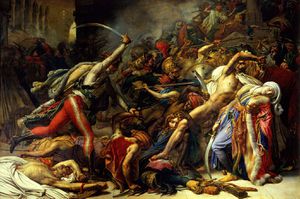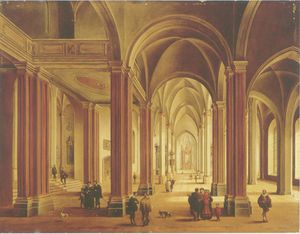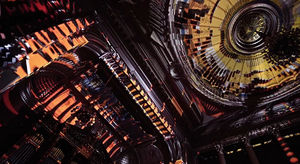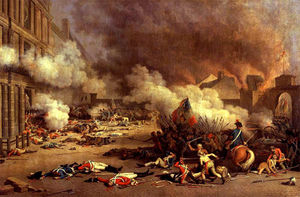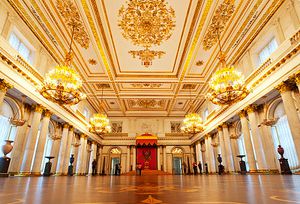Royal Hall of Music
The Royal Hall of Music is a storied place in the culture and arts of Sayaffallah; a place where the greats come to perform in front of their monarch and their fellow man and a place where the compositions of the learned are presented fresh for the world to hear for the first time. Yet this storied venue has a history mired in conflict and bloodshed and scandal dating back to the earliest times of Sayaffallah's present state.
History
The Beginning
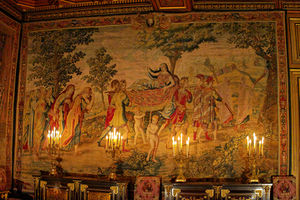
His Majesty King Heston II in the year 1435 conquered the lands of Alasabaster and returned victorious to a nation that beloved him as a hero. And on horseback the King rode into the capital of the empire as his path was lined with the snow of a thousand hand made scarves in his honour and as the King approached the palace the sound of singing could be heard and it was at this moment that the King could be heard to exclaim "Music shall not be confined by nature!" before galloping through the palace gates and into the palace proper itself. These prophetic words by King Heston were soon followed by a proclamation the day after his return from the war campaign in which he declared in honour of the troops of the empire a palace of music would be constructed on a scale bigger than anything that had been built at any time in the history of the country.
At this time the nation was staunchly Orthodox Christian and when the Patriarch of the Church Xastos I heard that a music palace would be built he gladly gave his approval. For if a Music Palace would be built it would surely be dedicated to God rather than to man and the Patriarch was confident that this would be the case. In earnest the structure was built with the King personally supervising its construction on a daily basis riding his horse down to the site of the project and encouraging the workmen to build like it was their last day on earth and work they did! The workmen put tremendous labor into the project and great slabs of marble and stone were brought from quarries in the north by large caravans and placed into the building causing it to rise like a phoenix into the sky. The costs were astronomical but the Patriarch generously funded the project as a monument to God and soon the heights of the building reached an astounding 600 ft (182.88 Meters) in height and continued to grow with gigantic columns in its interior and large columns extending outwards.
The Dedication
On December 24, 1490 King Heston lay on his deathbed as the colossal project continued to grow in size and cost and in his final moments he asked to be carried by his sons the Crown Princes of the empire to the site to receive final rites from the Patriarch in the inner hall of the Palace of Music. The great procession began out of the palace and soon the streets were lined with somber citizens wanting to pay their final respects to the King of the Empire and with feebled gestures the King raised his hand in blessing to the people. Historians record that a great sound of weeping could be heard along the route of the procession that only grew louder as the King reached the inner hall of the Royal Palace of Music and once in the inner hall only the innermost of the Kings court remained and it was then that the King gave his final breath and was pronounced dead. Upon his death the Patriarch gave the succession blessing to the King's eldest son Jacob Alexandros who chose the name of Alexandros I as his name. It was the wish of King Heston to be buried in the Palace of Music despite the tradition of Monarchs being buried in the Royal Cathedral. This prompted a protest by the Patriarch who stated that if the King was not buried in the Royal Cathedral it would symbolize a departure of the Monarch from the Church.
However Alexandros I refused the Patriarch and had his father buried in the Palace of Music in accordance with the late king's wishes. The Patriarch in retaliation declared that Alexandros had surrendered to the force of selfish wanton excess and had abandon the Orthodox faith. In doing so the Patriarch declared Alexandros reign as monarch to be invalidated and nullified and declared Alexandros to be an illegitimate monarch. This prompted a great uproar in the capital city of the empire and resulted in Alexandros ending construction and declaring the Royal Palace of Music dedicated to man rather than in the image of God. Alexandros youngest brother was then proclaimed true Monarch by the Patriarch in the Royal Cathedral and the people flocked to the younger brother who was chosen the name of Edward the Faithful out of reverence to the Orthodox Church.
The Palace of Music became a symbol of rebellion against the Orthodox Church and was soon marched upon by Edward the Faithful only to be rebuffed by the entirety of the palace guard who declared their loyalty to Alexandros. Edward was chased out of the capital city of the empire by the Royal Guard who declared Edward to be an enemy of the state and a scoundrel who must be punished by separation of the body otherwise known as drawing and quartering. Edward left the capital of the empire in short order and fled to the countryside where he gathered the people to himself.
The Great War of 1405
In 1405 the Patriarch fled to the countryside to join Edward after large mobs led by Alexandros sacked and pillaged the Royal Cathedral in the capital reducing it to a burned out ruin. The mob had intended to seize the Patriarch and to force him to recognize Alexandros as King of the Empire however the Patriarch was tipped off hours before the mob reached the cathedral giving the Patriarch time to disguise himself as a nun and to join a procession of nuns leaving the city for a shrine in the far northern mountains. When the Patriarch arrived at the encampment of Edward he gave the formal blessing to Edward and pronounced upon him the blessing of Kings in the full sight of the people. Edward in turn granted the Patriarch safe refuge for as long as he needs it and allowed the Patriarch to remain in his encampment.
Over the next few months Edward gathered together the people from the small villages that dotted the landscape of the empire and as more and more people came to his encampment Edward soon had an army of citizens in excess of 450,000 people. This army trained together and learned the tactics of war and marching and solidarity and soon by 1406 the army marched on the capital of the empire and was pushed back by the forces of Alexandros and pushed far back into the countryside. Their first fight had ended in disaster with the army of Edward being decimated by Alexandros and Edward being forced to hide in the caves along the coast. In 1407 Edward regathered and regrouped his army and they began to capture loyalist towns surrounding the capital of the empire and by 1408 they launched another attempt at the capital this time succeeding in decimating the loyalists by tunneling deep under the city and coming up through the Royal Palace itself. Edward beheaded Alexandros and mounted his head on a pike and suspended his body on a pillar outside of the main gate. The sight of the dead king's head caused the loyalists to surrender to Edward and peace was restored.
Restoration of Orthodoxy
The restoration of Orthodoxy began almost immediately with Edward the Faithful declaring the Holy Orthodox Church to be the only church recognized within the empire and the only church loyal to God. Edward declared that the Royal Palace of Music would be rebuilt and dedicated to Orthodoxy and that the Royal Cathedral would be rebuilt in a much larger and more spectacular fashion. From that point onwards until the invasion of the Islamic tribes in the 1600s the Palace of Music served as a symbol of the power of orthodoxy and the power of the empire. The Palace of music was dedicated to the success of the people and to the glory of God and was placed under the protection of the Cathedral Guard itself.
The Palace of Music in the 1500s became the sight of the holding of great concerts of the composers of the empire and became the residence of the musicians of the royal courts. The Palace of Music served as a palace first and foremost as the musicians of the empire were treated like demigods by many of the people of the empire but it also served as a performance hall open to all people regardless of station in life. The upper levels of the Palace of Music were reserved for the clergy while the large boxes wrapped in the Imperial Flag of State were reserved for the King of the Empire and his guests and family while the lower levels extending to the platform of performance were reserved exclusively for the people of the Empire regardless of their station or rank. In fact so great was the benevolence of the King that those seen preventing entrance to others often because of their station were taken out and flogged and prohibited from ever entering the palace of music again. The King was known to attend performances regularly in the Palace of Music and this increased the appeal of attending it for many of the people of the country.
The Islamic Invasion
In the 1600s the Islamic tribes invaded and slowly established strength throughout the empire and by 1704 the entire country was under the thumb of Islam. The Orthodox Church was dismantled by the Islamic Tribes and was not allowed to operate except for one service in the evening on Sunday and the Cathedral was converted into a mosque for use by the Islamic tribes at their leisure. The Palace of Music underwent a renovation extending from 1704 to 1726 and became a palace of music with distinctive Islamic architectural details including several domes added to the facility as a way of increasing acoustic sound depth and range. No longer was the Palace of Music open to the public, it was exclusively for the use of the Islamic Emperor and his court on pain of death. Several times the common folk would try to sneak into showings of performances as the old traditions once allowed them to do freely but each time they would be caught and publicly beheaded the next day in a public execution to deter future intances.
The Islamic period of time lasted until the early 1900s when the great revolution of state occurred. The Islamic Period saw statues draped in linens and cloths so as to prevent the gazer from seeing the classical nudity of the statue that might provoke thoughts of an immodest nature. Like wise even the columns were covered in cascading silks and linens so as to distract from the alleged phallic nature of the columns and to prevent impure thoughts in the hearts and minds of the women who might see it. The period of Islamic influence was a period in which great changes were made throughout the country not just in the Palace of Music.
The Great Revolution of 1900
In 1900 a confluence of factors primarily increasing poverty and disillusionment between the state and the people occurred prompting the people to bring back the Monarch once disbanded by the Islamic tribes. The people many of whom practiced Islam and others who still practiced Christianity desired to see their country made whole again. Many remembered the ancient stories passed down generation from generation of the prosperity that existed during the period of Orthodox before the Islamic Tribes invaded and many remembered the freedom that existed then as well.
In 1900 the revolution began in the countryside and soon spread to the cities and by 1905 the government was overthrown and the Grand Mosque was ransacked and soon after the Sultan of the Saints of Sayaffallah was coronated in a ceremony in the Palace of Music. The coronation established the Sultan as supreme ruler of the country and in his first act as Sultan he ordered that the Grand Mosque be returned to the Orthodox Church and that the Patriarch in Exile be allowed to return to the country. Further Sultan ordered that a Grand Mosque be constructed so as to ensure that the Islamic population not become disenfranchised as they now had a solid place within the society of Sayaffallah. And soon the work begna to reopen the Royal Palace of Music to the public and to return the Royal Cathedral to the Orthodox Church.
On December 1, 1902 the Patriarch returned in an elaborate procession in which he stopped at the Palace and kissed the ring of the Sultan signifying his respect for the state and then the Sultan led the Patriarch to the completed Royal Cathedral restored to its previous glory and the first service was held since its return to Orthodoxy, historians record that a great amount of joyful weeping could be heard as history righted itself and restored the balance of things within Sayaffallah. However the first performance in the Palace of Music came on July 1, 1903 and was open to the public and so great was the crowd that came that the doors were flung open so that the sound of the music could be heard by all outside. For a while there was concern that the concert would not be heard above the roar of the crowd outside but as soon as the first note of music began a pin could be dropped for the silence the enveloped the crowd of 2 million gathered outside that cathedral.
Modern attributes
The hall in present day serves as a performance space and is managed by the Royal Institute of Performing Arts and a council appointed by the Sultan. Both serve to ensure that the performance space is well taken care of by those who use it and that it is respected by the general public. The modern renovations that took place on June 6, 1994 saw the replacement of rotting timbers in the roof and the removal of the Islamic period domes which led to popular protest throughout the country, however the desire was to see a return to the Palace of Music as envisioned by King Heston II when it was first constructed. These renovations lasted for a period of 10 years and saw not just structural changes but interior changes to accomodate large scale productions involving extensive use of animals and pyrotechnics and special effects that otherwise would be impossible or too dangerous to use in an aging structure.
The periphery of the facility now includes dramatic hanging gardens featuring a wide variety of plants and trees that are adapted to seasonal usage including the installation of a winding river and several outdoor features. The interior includes a dramatic sweeping atrium connecting to the throne room which was renovated as the floor was beginning to crack and fade. The renovations of the throne room included the original throne being placed in the museum of state and a new throne of solid gold with inlaid diamonds and rubies being commissioned and installed on the original pedestal of marble which is still in excellent condition despite being in place since the days of King Heston II.


